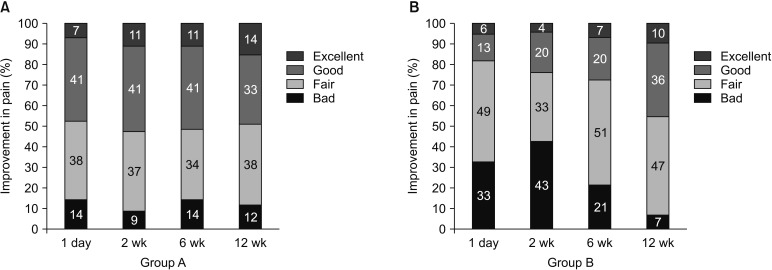Clin Orthop Surg.
2019 Mar;11(1):89-94. 10.4055/cios.2019.11.1.89.
Is It Radiculopathy or Referred Pain? Buttock Pain in Spinal Stenosis Patients
- Affiliations
-
- 1Department of Orthopaedic Surgery, Wonkwang University Hospital, Iksan, Korea.
- 2Department of Orthopaedic Surgery, Kosin University Gospel Hospital, Busan, Korea. mewha98@naver.com
- KMID: 2438338
- DOI: http://doi.org/10.4055/cios.2019.11.1.89
Abstract
- BACKGROUND
Buttock pain is common, and there are no fixed guidelines for its diagnosis and treatment. This study compared a selective nerve root block and a facet joint block for patients with degenerative spinal disease and buttock pain.
METHODS
Patients with degenerative spinal disease who presented with buttock pain, received a selective nerve root block (group A) or a facet joint block (group B) from June 2017 to September 2017, and were able to be followed up for more than 3 months were prospectively enrolled. Clinical results were assessed using a visual analog scale for comparative analysis.
RESULTS
One day after the procedure, an excellent response was found in 7% and 6% of groups A and B, respectively; a good response was found in 41% and 13% of groups A and B, respectively. Two weeks later, an excellent response was found in 11% and 4% of groups A and B, respectively; a good response was found in 41% and 20% of groups A and B, respectively. Six weeks later, an excellent response was found in 11% and 7% of groups A and B, respectively, and a good response was found in 41% and 20% of groups A and B, respectively. At the final follow-up, more than 47% and 46% of patients showed a good response in groups A and B, respectively. In group A, the visual analog scale score improved compared to the pre-procedure value of 5.01 to 2.74 on day 1, 2.51 at week 2, 2.38 at week 6, and 2.39 at week 12. In group B, the visual analog scale score improved compared to the preprocedure value of 5.24 to 3.94 on day 1, 3.99 at week 2, 3.24 at week 6, and 2.59 at week 12. On day 1 and at weeks 2 and 6, group A showed a significantly better outcome than group B (p < 0.05).
CONCLUSIONS
The selective nerve root block showed superior results up to 6 weeks post-procedure. Considering that the selective nerve root block is effective for treating radiculopathy, the primary cause of buttock pain can be thought to be radiculopathy rather than degenerative changes of the facet joint.
Keyword
MeSH Terms
Figure
Reference
-
1. Krempen JF, Smith BS, DeFreest LJ. Selective nerve root infiltration for the evaluation of sciatica. Orthop Clin North Am. 1975; 6(1):311–315. PMID: 123054.
Article2. Goebert HW Jr, Jallo SJ, Gardner WJ, Wasmuth CE. Painful radiculopathy treated with epidural injections of procaine and hydrocortisone acetate: results in 113 patients. Anesth Analg. 1961; 40:130–134. PMID: 13706221.3. Cooper G, Lutz GE, Boachie-Adjei O, Lin J. Effectiveness of transforaminal epidural steroid injections in patients with degenerative lumbar scoliotic stenosis and radiculopathy. Pain Physician. 2004; 7(3):311–317. PMID: 16858467.4. Hong YG, Sa SJ, Kim JD. Selective spinal nerve root block for the treatment of sciatica. J Korean Orthop Assoc. 1997; 32(4):1056–1062.
Article5. Narozny M, Zanetti M, Boos N. Therapeutic efficacy of selective nerve root blocks in the treatment of lumbar radicular leg pain. Swiss Med Wkly. 2001; 131(5-6):75–80. PMID: 11383229.6. Eubanks JD, Lee MJ, Cassinelli E, Ahn NU. Prevalence of lumbar facet arthrosis and its relationship to age, sex, and race: an anatomic study of cadaveric specimens. Spine (Phila Pa 1976). 2007; 32(19):2058–2062. PMID: 17762805.7. Mooney V, Robertson J. The facet syndrome. Clin Orthop Relat Res. 1976; (115):149–156.
Article8. Donovan WH, Dwyer AP, White BW, Batalin NJ, Skerritt PW, Bedbrook GM. A multidisciplinary approach to chronic low-back pain in Western Australia. Spine (Phila Pa 1976). 1981; 6(6):591–597. PMID: 6461071.
Article9. Laplante BL, Ketchum JM, Saullo TR, DePalma MJ. Multivariable analysis of the relationship between pain referral patterns and the source of chronic low back pain. Pain Physician. 2012; 15(2):171–178. PMID: 22430655.10. Lee GY, Lee JW, Choi HS, Oh KJ, Kang HS. A new grading system of lumbar central canal stenosis on MRI: an easy and reliable method. Skeletal Radiol. 2011; 40(8):1033–1039. PMID: 21286714.
Article11. Lee S, Lee JW, Yeom JS, et al. A practical MRI grading system for lumbar foraminal stenosis. AJR Am J Roentgenol. 2010; 194(4):1095–1098. PMID: 20308517.
Article12. Macnab I, MacCulloch J. Backache. 2nd ed. Baltimore: Williams and Wilkins;1990. p. 22–25.13. Robinson JP, Brown PB, Fisk JD. Pathophysiology of lumbar radiculopathies and the pharmacology of epidural corticosteroids and local anesthetics. Phys Med Rehabil Clin N Am. 1995; 6(4):671–690.
Article14. Marks R. Distribution of pain provoked from lumbar facet joints and related structures during diagnostic spinal infiltration. Pain. 1989; 39(1):37–40. PMID: 2530485.
Article15. Mehta M, Sluijter ME. The treatment of chronic back pain: a preliminary survey of the effect of radiofrequency denervation of the posterior vertebral joints. Anaesthesia. 1979; 34(8):768–775. PMID: 160757.16. Bernard TN Jr, Kirkaldy-Willis WH. Recognizing specific characteristics of nonspecific low back pain. Clin Orthop Relat Res. 1987; (217):266–280.17. Allegri M, Montella S, Salici F, et al. Mechanisms of low back pain: a guide for diagnosis and therapy. F1000Res. 2016; 5:1530.
Article
- Full Text Links
- Actions
-
Cited
- CITED
-
- Close
- Share
- Similar articles
-
- Definition of lumbar spinal pain
- Spinal epiduroscopy as an educational tool
- Percutaneous Treatment with Steroid Injections and Distension of Facet Synovial Cyst: A case report
- Foraminal stenosis complicating retained broken epidural needle tip: A case report
- Conservative Treatment of Thoracic Radiculopathy due to Ossification of the Yellow Ligament in a Young Patient: A case report


